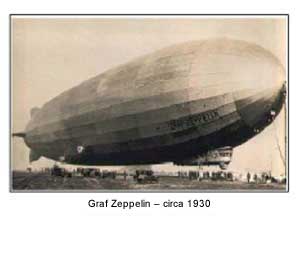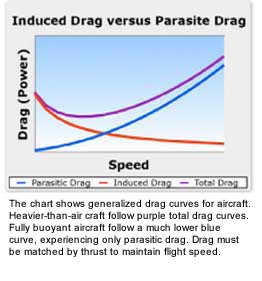 |


 Buoyant Flight is an inherently efficient form of transportation. This is the main reason why skyships were so promising in the 1920s when airplanes still seemed a speculative venture. While today they are forgotten by many, skyships were actually very successful. By 1937, commercial passenger skyships of the Deutsche Zeppelin Reederei (DZR) had flown over half a million passenger-hours and a total of 52 million passenger-km safely on regional, transoceanic, transcontinental and artic voyages. All of this was accomplished using then state-of-the-art technology that by today's standards would be considered quite primitive. The lifting gas used, flammable hydrogen, was contained within large cells made from the membranes of cow intestines. The hull was covered in a doped cotton canvas, and control systems were operated manually by a large crew. Nevertheless, due to their efficiency, skyships still did perform astounding feats and set records for aerial transportation.
Buoyant Flight is an inherently efficient form of transportation. This is the main reason why skyships were so promising in the 1920s when airplanes still seemed a speculative venture. While today they are forgotten by many, skyships were actually very successful. By 1937, commercial passenger skyships of the Deutsche Zeppelin Reederei (DZR) had flown over half a million passenger-hours and a total of 52 million passenger-km safely on regional, transoceanic, transcontinental and artic voyages. All of this was accomplished using then state-of-the-art technology that by today's standards would be considered quite primitive. The lifting gas used, flammable hydrogen, was contained within large cells made from the membranes of cow intestines. The hull was covered in a doped cotton canvas, and control systems were operated manually by a large crew. Nevertheless, due to their efficiency, skyships still did perform astounding feats and set records for aerial transportation.
 Skyships are so named because they float. Instead of floating on a sea of water, skyships ride in a sea of air. While marine ships must part the waves, skyships merely part the air, which is a decidedly less viscous medium. The energy expended to accomplish this task is therefore considerably smaller. Furthermore, unlike heavier-than-air craft, the lift for skyships is obtained primarily through displacement, and not aerodynamic lift. This is significant because when aerodynamic lift is produced, drag is unavoidably induced. So while both skyships and airplanes must overcome parasitic drag, airplanes must also expend a significant amount of energy to overcome induced drag. This extra drag in an airplane is greatest at lower speeds, whereas skyships are at their most efficient operations. Skyships are so named because they float. Instead of floating on a sea of water, skyships ride in a sea of air. While marine ships must part the waves, skyships merely part the air, which is a decidedly less viscous medium. The energy expended to accomplish this task is therefore considerably smaller. Furthermore, unlike heavier-than-air craft, the lift for skyships is obtained primarily through displacement, and not aerodynamic lift. This is significant because when aerodynamic lift is produced, drag is unavoidably induced. So while both skyships and airplanes must overcome parasitic drag, airplanes must also expend a significant amount of energy to overcome induced drag. This extra drag in an airplane is greatest at lower speeds, whereas skyships are at their most efficient operations.
Related Links
Environmental Impact in PDF Form
Environmental Impact Summary (144kb)
World Sky Race Program in PDF Form
World Sky Race Program
|
 |
|
 |